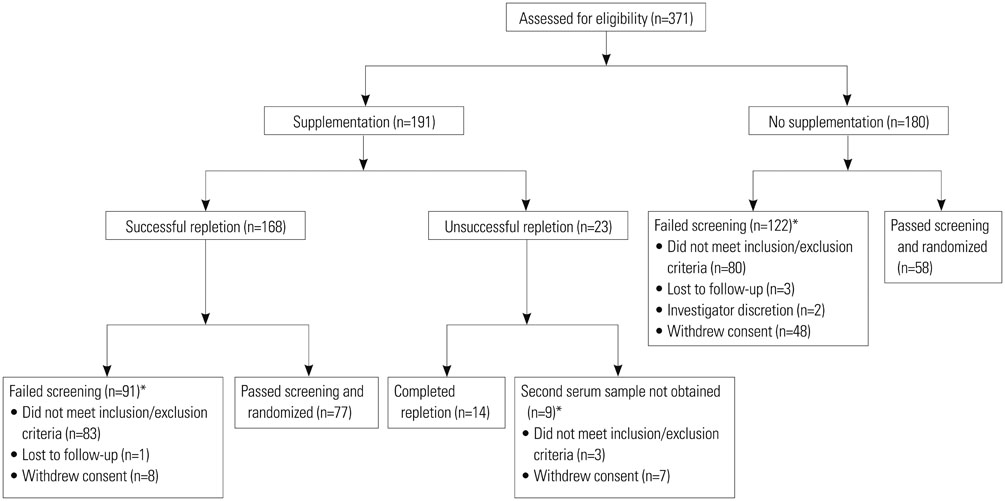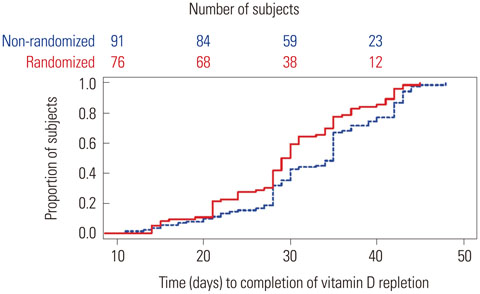Yonsei Med J.
2016 Jul;57(4):923-927. 10.3349/ymj.2016.57.4.923.
Vitamin D Repletion in Korean Postmenopausal Women with Osteoporosis
- Affiliations
-
- 1Department of Endocrinology and Metabolism, Ajou University School of Medicine, Suwon, Korea.
- 2Division of Endocrinology and Metabolism, Department of Internal Medicine, Chonnam National University Medical School, Gwangju, Korea.
- 3Department of Endocrinology and Metabolism, Seoul St. Mary's Hospital, The Catholic University of Korea, Seoul, Korea.
- 4Department of Endocrinology and Metabolism, Pusan National University Hospital, Busan, Korea.
- 5Division of Endocrinology and Metabolism, Asan Medical Center, University of Ulsan College of Medicine, Seoul, Korea.
- 6Division of Endocrinology and Metabolism, Department of Medicine, Samsung Medical Center, Sungkyunkwan University School of Medicine, Seoul, Korea.
- 7Department of Family Medicine, Cheil General Hospital, College of Medicine, Kwandong University, Seoul, Korea.
- 8Department of Orthopedic Surgery, Kyungpook National University Hospital, Daegu, Korea.
- 9GlaxoSmithKline, Seoul, Korea, Korea.
- 10GlaxoSmithKline, Collegeville, PA, USA. barbara.g.kravitz@gsk.com
- KMID: 2374124
- DOI: http://doi.org/10.3349/ymj.2016.57.4.923
Abstract
- PURPOSE
Up to 71% of South Korean postmenopausal women have vitamin D deficiency {serum 25-hydroxyvitamin D [25(OH) D] level <50 nmol/L}. Data on vitamin D supplementation was collected during the screening phase of an efficacy/safety study of denosumab in Korean postmenopausal women with osteoporosis. This report describes the effect of vitamin D supplementation on repletion to 25(OH)D levels ≥50 nmol/L in Korean postmenopausal women with osteoporosis.
MATERIALS AND METHODS
Vitamin D levels of Korean postmenopausal women (60-90 years old) were measured by extracting 25(OH)D2 and 25(OH)D3 from serum samples via protein precipitation and using liquid chromatography with tandem mass spectrometry detection. Calibration curves were constructed from the mass chromatograms to obtain total vitamin D levels. Subjects with serum 25(OH)D levels <50 nmol/L were supplemented with 1000 IU of vitamin D tablets during the 2.5-month-long screening period. Dose, frequency, and duration were determined by the investigator. If repletion was achieved (≥50 nmol/L) on retest, subjects were eligible to be rescreened for study entry.
RESULTS
Of 371 subjects screened, 191 (52%) required vitamin D supplementation, and 88% (168 of 191) were successfully repleted. More than half of the subjects (58%) who were successfully repleted received doses of 2000 IU daily. The mean time to successful repletion was 31 days (standard deviation 8.4 days; range 11-48 days).
CONCLUSION
Supplementation with daily median doses of 2000 IU vitamin D successfully repleted 88% of Korean postmenopausal women with osteoporosis within 48 days to a serum vitamin D level of 50 nmol/L.
Keyword
MeSH Terms
-
Aged
Aged, 80 and over
*Asian Continental Ancestry Group
Bone Density Conservation Agents/*therapeutic use
*Dietary Supplements
Double-Blind Method
Female
Humans
Middle Aged
Osteoporosis, Postmenopausal/*complications/drug therapy/ethnology
Postmenopause/blood
Republic of Korea
Vitamin D/analogs & derivatives/blood/*therapeutic use
Vitamin D Deficiency/diagnosis/*drug therapy/ethnology
Bone Density Conservation Agents
Vitamin D
Figure
Reference
-
1. Watts NB, Bilezikian JP, Camacho PM, Greenspan SL, Harris ST, Hodgson SF, et al. American Association of Clinical Endocrinologists Medical Guidelines for Clinical Practice for the diagnosis and treatment of postmenopausal osteoporosis. Endocr Pract. 2010; 16:Suppl 3. 1–37.
Article2. Prentice RL, Pettinger MB, Jackson RD, Wactawski-Wende J, Lacroix AZ, Anderson GL, et al. Health risks and benefits from calcium and vitamin D supplementation: Women's Health Initiative clinical trial and cohort study. Osteoporos Int. 2013; 24:567–580.
Article3. Bischoff-Ferrari HA, Willett WC, Orav EJ, Lips P, Meunier PJ, Lyons RA, et al. A pooled analysis of vitamin D dose requirements for fracture prevention. N Engl J Med. 2012; 367:40–49.
Article4. Hong H, Kim EK, Lee JS. Effects of calcium intake, milk and dairy product intake, and blood vitamin D level on osteoporosis risk in Korean adults: analysis of the 2008 and 2009 Korea National Health and Nutrition Examination Survey. Nutr Res Pract. 2013; 7:409–417.
Article5. Lips P, Hosking D, Lippuner K, Norquist JM, Wehren L, Maalouf G, et al. The prevalence of vitamin D inadequacy amongst women with osteoporosis: an international epidemiological investigation. J Intern Med. 2006; 260:245–254.
Article6. Choi HS, Oh HJ, Choi H, Choi WH, Kim JG, Kim KM, et al. Vitamin D insufficiency in Korea--a greater threat to younger generation: the Korea National Health and Nutrition Examination Survey (KNHANES) 2008. J Clin Endocrinol Metab. 2011; 96:643–651.
Article7. Koh JM, Oh HJ, Park IH, Kim IJ, Kang MI, Lim SK, et al. Efficacy and safety results from a six month double-blind study comparing 60 mg denosumab (DMAb) and placebo in Korean postmenopausal women with osteoporosis. J Bone Miner Res. 2013; 28:Suppl 1. accessed on 2014 January 6. Available at: http://www.asbmr.org/asbmr-2013-abstract-detail?aid=f2f88d4e-888b-4ef4-b170-4244d1d6d02c .8. Pepper KJ, Judd SE, Nanes MS, Tangpricha V. Evaluation of vitamin D repletion regimens to correct vitamin D status in adults. Endocr Pract. 2009; 15:95–103.
Article9. Vande Griend JP, McQueen RB, Linnebur SA, Vondracek SF. Prescription ergocalciferol dosing for vitamin D repletion: a retrospective evaluation. Pharmacotherapy. 2012; 32:135–141.
Article10. Cummings SR, San Martin J, McClung MR, Siris ES, Eastell R, Reid IR, et al. Denosumab for prevention of fractures in postmenopausal women with osteoporosis. N Engl J Med. 2009; 361:756–765.
Article11. Holick MF. Vitamin D deficiency. N Engl J Med. 2007; 357:266–281.
Article
- Full Text Links
- Actions
-
Cited
- CITED
-
- Close
- Share
- Similar articles
-
- The Vitamin D perception survey on Korean postmenopausal women in the treatment of osteoporosis
- Current Treatment of Postmenopausal Osteoporosis
- The Effect of Vitamin K2 in Addition to Risedronate on the Patients with Postmenopausal Osteoporosis
- Combined Treatment with Vitamin K2 and Bisphosphonate in Postmenopausal Women with Osteoporosis
- Comparison of Proportions of Lymphocyte Subsets According to Serum 25(OH) Vitamin D Levels in Postmenopausal Women



